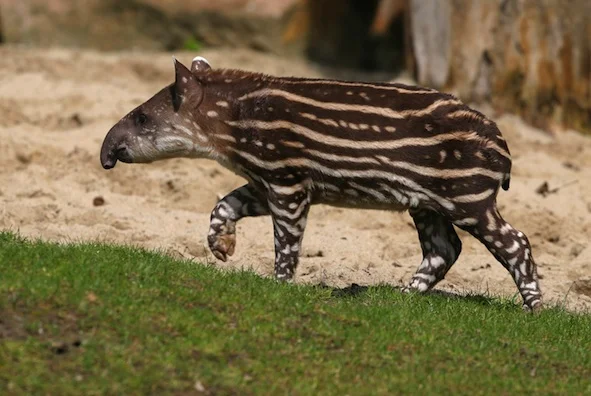Tapirs are big animals.
They live in forests and jungles.
They have a nose that works like a hand.
They can swim.
Tapirs eat only plants.
Brazilian tapir ©Getty Images
Tapirs are large mammals with short snouts that are very flexible.
Species
There are four, or possibly five, species, or kinds, of tapir
In the jungles and forests in South and Central America are the :
Baird's tapir;
lowland or Brazilian tapir;
mountain tapir
In 2013, what may be a new species was discovered, though it has to be established whether it is or if it is a young one of one of the existing species. It is called the kabomani tapir, also known as the little black tapir
And in Southeast Asia: southern Thailand and southern Myanmar (Burma), through the Malayan Peninsula and on the Indonesian island of Sumatra:
the Malayan tapir (sometimes called the Asian tapir).
Tapirs are in a group of animals called 'odd-toed ungulates'. An ungulate is a mammal with hooves (or hoofs, either is correct). A hoof is really a sort of toenail. Some ungulates have a hoof that is split in two (such as pigs or antelope) while others have an odd number of toes.
Ungulates are hoofed mammals
The tapir's closest relatives are the other odd-toed ungulates, horses and rhinoceroses. Tapirs' front legs have four toes, and back legs have three toes.
Tapirs have changed very little in tens of thousands of years, and are like living fossils.
Baird's tapir ©Getty Images
Body
Tapirs have a prehensile nose, which means it can grasp things. Like an elephant's trunk, the tapir's nose is used to grab and pick leaves to feed on, and as a snorkel while swimming.
They have strong teeth for chewing tough plants. Their hides are very tough and their bodies have a streamlined shape for easy movement in the forest.
Malayan tapir ©GettyImages
The Malayan tapir is the largest of the four species, standing about one metre high at the shoulder and weighing about 300 kilograms. Its distinctive colouring, a black front section and white rear section, make it stand out during the day, but camouflage it well at night. In the shadowy, moonlit rainforest at night, the Malayan tapir is almost invisible.
The lowland, or Brazilian, tapir has a ridge of stiff hair on its head from ears to shoulder like a mane. The kabomani is the smallest of all five tapirs.
The mountain tapir is the largest mammal on the South American continent.
©Getty Images
Behaviours
Tapirs are solitary animals, which means they live alone, except when a female has a young one. They are nocturnal (active at night) and crepuscular (active at dawn and dusk). They are able to run quickly. Because they are large, they have few predators. They swim, and walk about on the bottom of rivers and streams.
Baird's tapir ©Getty Images
Diet
Tapirs are herbivores, eating only plants: leaves, buds and fruit, as well as underwater plants gathered as they graze along the bottom of streams. They tug at the plants with their nostrils, using them like fingers.
Tapirs are important "seed dispersers" which means they swallow the seeds of plants, which are then dropped far away in their scat (poo) which helps the forest to regenerate.
Young tapir ©Getty Images
Life Cycle
Solitary males and females find each other to mate, and then go their separate ways. A female gives birth to a single young after a long pregnancy of 13 months.
©Getty Images
A young tapir is patterned with horizontal bands and spots of black or brown and white. Young are believed to stay with their mothers for two or three years.
Conservation Status and threats
All five species of tapir are classified as Endangered or Vulnerable. Tapirs are hunted for meat and for their skin. Their habitats are being destroyed by logging and farming.
It is always a good idea to use more than one source of information, so here are some others for you to investigate
Watch a South American lowland tapir underwater
https://thekidshouldseethis.com/post/why-do-tapirs-like-being-underwater
Read about some tapir species
https://www.worldlandtrust.org/species/mammals/lowland-tapir/









